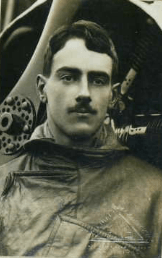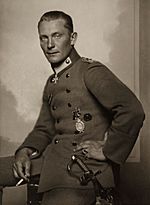Ralph Curtis facts for kids
Quick facts for kids
Ralph Luxmore Curtis
|
|
|---|---|

Ralph Luxmore Curtis
|
|
| Born | 19 March 1898 Rainham, Essex, England |
| Died | 21 September 1917 (aged 19) West Flanders, Belgium |
| Buried | (50°51′33″N 3°19′27″E / 50.85917°N 3.32417°E) |
| Allegiance | |
| Service/ |
|
| Rank | Second Lieutenant |
| Unit | No. 48 Squadron Royal Flying Corps |
Second Lieutenant Ralph Luxmore Curtis was a brave British pilot during World War I. He was born on March 19, 1898, and sadly passed away on September 21, 1917. Ralph was known as a "flying ace" because he shot down fifteen enemy planes.
He died from injuries he got while fighting in the air against Hermann Göring. Göring was a famous German pilot who led a group called Jasta 27. Ralph Curtis was buried twice in Belgium and is also remembered on the Rainham War Memorial in England.
Contents
Early Life
Ralph Luxmore Curtis was born in a place called Rainham, Essex, England. His birthday was March 19, 1898.
His father, William Curtis, was a farmer. Ralph grew up with his family at Berwick Pond, which was also known as Berwick Manor.
Becoming a Pilot
Ralph Curtis earned his pilot's license on February 17, 1917. He trained at the London and Provincial School in Hendon, England.
To join the Royal Flying Corps, Ralph changed his birth year. He said he was born in 1896, making himself two years older. This meant he was 18 when he joined. He became a second lieutenant and flew with No. 48 Squadron.
Aerial Victories
Ralph Luxmore Curtis became a flying ace with fifteen victories in the air. He flew a type of plane called a Bristol F.2b, also known as a Bristol Fighter.
Most of his victories, thirteen of them, were with his observer, Second Lieutenant Desmond Percival Fitzgerald Uniacke.
First Victories
Ralph got his first victory on June 16, 1917. His observer was Second Lieutenant Laurence W. Allen. They destroyed an Albatros D.III plane. This was Allen's tenth and last victory.
On July 3, 1917, Ralph and Uniacke made an enemy two-seater plane crash out of control. Two days later, they sent an Albatros D.V out of control over Bapaume, France.
Ralph's fourth victory was on July 7, 1917, when he and Uniacke destroyed another Albatros D.V. Later that month, on July 28, they sent an Albatros D.III out of control.
Double Victories
On August 16, 1917, Ralph and Uniacke had a double victory. They fought two Albatros D.V planes. One was destroyed in flames, and the other crashed out of control.
Ralph had four more victories between August 20 and September 2, 1917. On August 20, he and Uniacke sent an Albatros D.V out of control.
Two days later, Ralph had another double victory. He and Uniacke destroyed one Albatros D.V and sent another out of control.
His eleventh victory happened on September 2, 1917. He and Uniacke sent an Albatros D.V out of control. This victory was shared with another pilot, Lieutenant Keith Rodney Park, and his observer.
On September 5, 1917, Ralph had two more victories with different observers. One was with Uniacke, and they sent a DFW C plane out of control. Later that day, with observer Second Lieutenant H Munro, he shot down an Albatros D.V in flames.
Ralph's fourteenth victory was on September 14, 1917. He and Uniacke destroyed an Albatros D.V. His final victory was on September 17, 1917. He and Uniacke sent a two-seater plane out of control. This victory was shared with another crew.
His Last Battle

On September 21, 1917, Ralph Curtis and his observer, Desmond Uniacke, were in a fight. They were flying their Bristol Fighter plane. They fought against Hermann Göring, who was a German pilot.
Their plane was shot down by Göring. Uniacke was captured and became a prisoner of war. Sadly, Ralph Curtis died that same day from his injuries. He passed away at a German medical station.
Ralph was first buried at the Hooglede German Military Cemetery in Belgium. In 1924, his remains were moved to the Harlebeke New British Cemetery. His headstone says: "Second Lieutenant R.L. Curtis Royal Flying Corps 21 September 1917 Age 19 Sans Peur Et Sans Reproche (Without Fear And Beyond Reproach)." He is also honored on the Rainham War Memorial.
Aircraft in His Story





